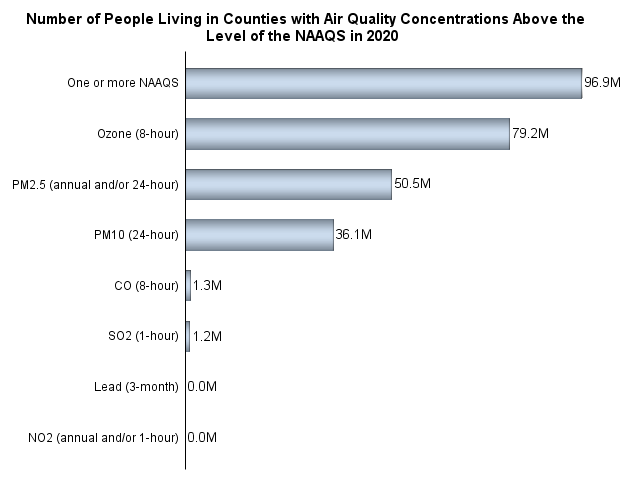What Was the Cause of Air Pollution to Rise Again in the 1990s Moscos
On this folio:
- Air Quality Trends
- Emission Trends
- Weather Influence
Air Quality Trends
EPA creates air quality trends using measurements from monitors located across the country. The table below prove that air quality based on concentrations of the common pollutants has improved nationally since 1980.
| 1980 vs 2020 | 1990 vs 2020 | 2000 vs 2020 | 2010 vs 2020 | |
|---|---|---|---|---|
| Carbon Monoxide | -81 | -73 | -57 | -12 |
| Lead | -98 | -98 | -93 | -86 |
| Nitrogen Dioxide (almanac) | -67 | -61 | -53 | -29 |
| Nitrogen Dioxide (1-hr) | -64 | -54 | -39 | -21 |
| Ozone (8-hr) | -33 | -25 | -20 | -10 |
| PM10 (24-60 minutes) | --- | -26 | -27 | +9 |
| PM2.v (almanac) | --- | --- | -41 | -18 |
| PM2.v (24-hour) | --- | --- | -xxx | +3 |
| Sulfur Dioxide (1-hour) | -94 | -91 | -85 | -74 |
Emissions Trends
EPA estimates nationwide emissions of ambient air pollutants and the pollutants they are formed from (their precursors). These estimates are based on bodily monitored readings or engineering calculations of the amounts and types of pollutants emitted by vehicles, factories, and other sources. Emission estimates are based on many factors, including levels of industrial activity, technological developments, fuel consumption, vehicle miles traveled, and other activities that cause air pollution.
Emissions data is developed with input from state and local air agencies, tribes, and manufacture. EPA tracks a range of emissions information, including how much of each pollutant is emitted from various pollution sources. To view national, country, and local emissions summary information, see EPA's Air Emissions Sources site. The table below shows that emissions of the common air pollutants and their precursors have been reduced essentially since 1980.
| 1980 vs 2020 | 1990 vs 2020 | 2000 vs 2020 | 2010 vs 2020 | |
|---|---|---|---|---|
| Carbon Monoxide | -75 | -70 | -57 | -29 |
| Atomic number 82* | -99 | -87 | -76 | -30 |
| Nitrogen Oxides (NOx) | -70 | -68 | -64 | -46 |
| Volatile Organic Compounds (VOC) | -60 | -48 | -29 | -20 |
| Direct PM10 | -64 | -31 | -28 | -nineteen |
| Directly PM2.v | --- | -38 | -44 | -22 |
| Sulfur Dioxide | -93 | -92 | -89 | -76 |
*Every bit a event of the permanent phase-out of leaded gasoline, controls on emissions of lead compounds through EPA'south air toxics plan, and other national and land regulations, airborne atomic number 82 concentrations in the U.S. decreased 98 per centum betwixt 1980 and 2005. After 2005, the EPA methodology for lead inverse and is not comparable to the 2005 and earlier numbers. Since 2008, emissions have connected to decrease by 30 percentage from 2008 to 2017. In the 2017 NEI, the highest amounts of Pb emissions are from Piston Engine Aircrafts, and Ferrous and Non-ferrous Metals industrial sources. The 2008 and 2017 estimates were used to approximate the 2010 to 2020 percent alter.
Emissions of air pollutants go on to play an important office in a number of air quality issues. In 2020, nigh 68 one thousand thousand tons of pollution were emitted into the atmosphere in the Usa. These emissions mostly contribute to the germination of ozone and particles, the degradation of acids, and visibility damage. To get detailed information nigh emissions estimates displayed below, delight visit EPA's Air Pollutant Emissions Trends Data.
Annual emissions estimates are used equally one indicator of the effectiveness of our programs. The graph below shows that between 1980 and 2020, gross domestic product increased 173 per centum, vehicle miles traveled increased 85 percent, energy consumption increased 19 percent, and U.S. population grew by 46 percent. During the same time period, full emissions of the six main air pollutants dropped by 73 pct. The graph too shows that between 1980 and 2019, COii emissions increased by 11 percent.

Gross Domestic Product: Bureau of Economical Analysis
Vehicle Miles Traveled: Federal Highway Assistants
Population: Demography Bureau
Energy Consumption: Dept. of Free energy, Energy Information Administration
Aggregate Emissions: EPA's Air Pollutant Emissions Trends Data
See this graph for 1970-2020

Despite great progress in air quality improvement, approximately 97 million people nationwide lived in counties with pollution levels higher up the principal NAAQS in 2020.

In add-on, from 1990 to 2017 emissions of air toxics declined by 74 percent, largely driven by federal and state implementation of stationary and mobile source regulations.
In recent years, EPA has acted to dramatically improve America's air quality by designing and developing national programs that, when fully implemented, volition achieve significant reductions in air emissions. The associated air quality benefits will atomic number 82 to improved health, longevity, and quality of life for all Americans.
Weather condition Influence
Weather conditions influence emissions and air quality. EPA has developed statistical approaches to account for weather condition's influence on ozone and fine particles. While these approaches do not alter the quality of air we breathe, they exercise aid u.s. sympathise how well emission reduction programs are working. More data is available for trends in ozone adjusted for weather conditions.
Source: https://www.epa.gov/air-trends/air-quality-national-summary